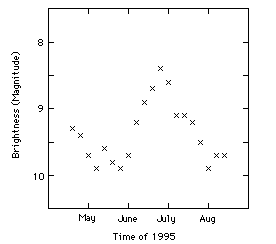|
|
Lightcurves and What They Tell Us
A light curve is a graph that shows the brightness of an object over a
period of time. In the study of objects that change their brightness over
time such as novae, supernovae, and variable stars, the light curve is a
simple, but valuable tool to a scientist. A sample light curve is shown in
Figure 1. This is the graph, or plot, generated from the following
data:
| Date | Brightness (Magnitude) | Date | Brightness (Magnitude)
|
|---|
| April 21 | 9.2 | June
20 | 8.7
| | April 27 | 9.3 | June
26 | 8.3
| | May 3 | 9.7 | July
2 | 8.6
| | May 9 | 9.9 | July
8 | 9.1
| | May 15 | 9.6 | July
14 | 9.1
| | May 21 | 9.8 | July
20 | 9.2
| | May 27 | 9.9 | July
26 | 9.5
| | June 2 | 9.7 | Aug
1 | 9.9
| | June 8 | 9.1 | Aug
7 | 9.7
| | June 14 | 8.8 | Aug
13 | 9.7
|

Figure 1
Here we have shown how bright the object would look to us through a
telescope if we measured it every 6 days for a few months. This gives us a
light curve of the object we have measured. But light curves can be
generated for any physical measurement which is repeated over and over in
time. So, if I measured the number of X-rays being emitted by a star during
every second for an hour, I could generate a light curve from my
observations. Or I could count how many people passed in front of me
during a ten minute time interval while I sat on a park bench during my
lunch hour. I could generate a light curve for this as well, but it would
have no astronomical value (of course!). Astronomers call them light curves
because it is usually some part of the electromagnetic spectrum (i.e.
light) that we measure as a function of time and use to help us understand
our universe.
How do we use light curves to tell us something
useful?
The record of changes that a light curve provides can help an astronomer in
understanding both the processes at work within the star (or stellar
system) and to identify specific categories (or classes) of stellar events.
For example, once a light curve has been made for a stellar object, it can
be compared to standard light curves to help identify the type of object
that is being studied.
If the light curve you measured looked like Figure 2, then you could
identify your object as an eclipsing binary star. We can also tell from
this light curve that it takes 10 days for one of the stars in the binary
to orbit around the other one complete time. Astronomers would say this as
"the orbital period of the binary system is 10 days."

Figure 2
|
